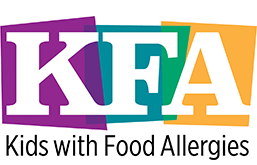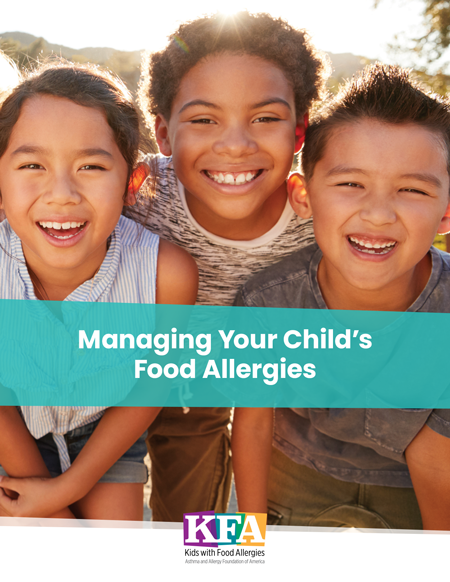Nutrition & Health

Nutrition and Food Allergies
Removing foods from your child’s diet can lead to the loss of important nutrients. A balanced, nutrient-rich diet is vital for a child’s growth and development.
Before removing foods from your child’s diet, it’s important to have an accurate diagnosis. Seek a referral to an allergist to discuss possible food allergies.
If your child receives a diagnosis of food allergy, ask your allergist to confirm which foods they should avoid and which foods they should keep eating.
Learning how to substitute healthy, safe alternatives is important. You may need to seek the advice of a registered dietitian to help you plan a healthy allergy-friendly diet for your child.
Milk Allergy
Milk is one of the most common food allergies in young children.1 Milk provides a good source of many nutrients essential for bone mineralization and growth. These nutrients are especially important during peak growth periods. These nutrients include: protein, calcium, vitamin D, vitamin A, vitamin B12, riboflavin and phosphorus.
In order for your child to replace these nutrients, you must carefully choose food substitutes. Meats, poultry, eggs, fish, nuts, and legumes can easily provide needed protein.
But, to get enough calcium, your child may need to eat lots of non-dairy food sources containing calcium. This may be more than a young child is capable of eating. For example, one cup of leafy greens contains as much calcium as 4 ounces of milk. A child who needs 500 milligrams of calcium daily would need to eat as much as 4 cups of leafy greens to meet the requirement. You will need to read labels to carefully seek out a variety of calcium-fortified foods.
In some cases, you may need to give your child supplements or an appropriate milk-free formula.
You may be able to use milk alternatives as an acceptable substitute if your child is over one year old. You can substitute soy milk, fortified rice milk, grain and nut milks (such as oat milk and almond milk) if tolerated. Be sure to read labels to make sure these milk substitutes are fortified with extra nutrients. For example, look for the nutrition information on the package to check the amount of protein. There should be 8 grams per 8 ounce serving. Calcium fortified juices will provide extra calcium, but are not a good source of other nutrients.
Egg Allergy
Children with egg allergy must avoid egg in all forms, unless their allergy specialist recommends otherwise.
Eggs provide a source of quality protein as well as iron, biotin, folacin, pantothenic acid, riboflavin, selenium, and vitamins A, D, E and B12. Your child can get an adequate amount of protein from other protein sources, such as: milk, meat, poultry, fish, nuts, and legumes. Meat can also supply selenium and vitamin B12. Folacin is in legumes, fruits and leafy greens. If your child consumes a variety of other foods, an egg-free diet should not place your child at nutritional risk.
A child avoiding foods containing egg may lose essential nutrients from the diet. For example, most baked goods use enriched and fortified flour, which contains B vitamins and iron. A child avoiding baked goods will need to get extra calories, B vitamins, iron and extra nutrients from other egg-free sources.
Peanut and Tree Nut Allergy
Peanuts and tree nuts are a good source of protein in a child’s diet. Yet, if your child needs to avoid nuts of any type, they should not be at nutritional risk. There are many other sources of protein as previously mentioned. Peanuts also provide a source of niacin, magnesium, vitamins E and B6, manganese, pantothenic acid, chromium, folacin, copper and biotin. Your child can get these vitamins and nutrients by consuming a variety of foods from other food groups.
Soy Allergy
Soybeans provide one of the highest quality proteins in a child’s diet. They also contain thiamin, riboflavin, iron, phosphorus, magnesium, calcium, zinc and vitamin B6. These are present in specific soy foods. The small amounts of soy in processed foods do not supply a significant amount of these nutrients. A soy-restricted diet should not pose a nutritional problem if your child eats a variety of fruits, vegetables, enriched and fortified grains, and tolerated sources of protein.
Wheat Allergy
Wheat is a grain you can replace with other grains. Allergies to other grains like corn, rice, barley, buckwheat, and oats are not common. But, you will need to choose other grains with care due to the possibility of cross contact. Be sure to choose alternate grains from a reputable source.
Wheat is often fortified with additional nutrients. The milling process for grains can also remove important nutrients, so make sure you choose fortified and enriched grains. A serving or two of an enriched and fortified grain at each meal will contribute to meeting important nutritional needs for B vitamins, folacin and iron.
You can substitute wheat flour with other fortified grain flours in recipes to provide the same nutrients as wheat. But, replacing wheat flour with other grain flours can affect how the recipe turns out. Follow your recipe carefully to get the best result.
Fish Allergy
Fish is a good source of protein. Fish contains the nutrients niacin, vitamins B6, B12, A and E. Fish also contains phosphorus, selenium, magnesium, iron and zinc. If your child must avoid fish, you can find the same nutrients in other protein sources such as meats, grains and legumes.
Ingredients to Avoid (How to Read Labels)
It is important to read every label, every time. Use our guides to help you know the different food names for your child’s allergens. Small, travel-size cards for chefs are also available to print.
Finding a Registered Dietitian
Tips to help you find a registered dietitian who specializes in food allergies.
Replacing Lost Nutrients
Nutrients are necessary for proper growth and development. Removing two or more important foods can result in poor nutrition. So , it is important to meet your child’s nutritional needs with a balanced diet.
Formula Options for Infants with Food Allergies
If breastfeeding isn’t an option, what formula should you introduce to your baby that is showing signs of allergy or intolerance?
Updated December 2022
Ask the Allergist
Have a question on managing food allergies, asthma, other allergic conditions? Our allergist can help.




















